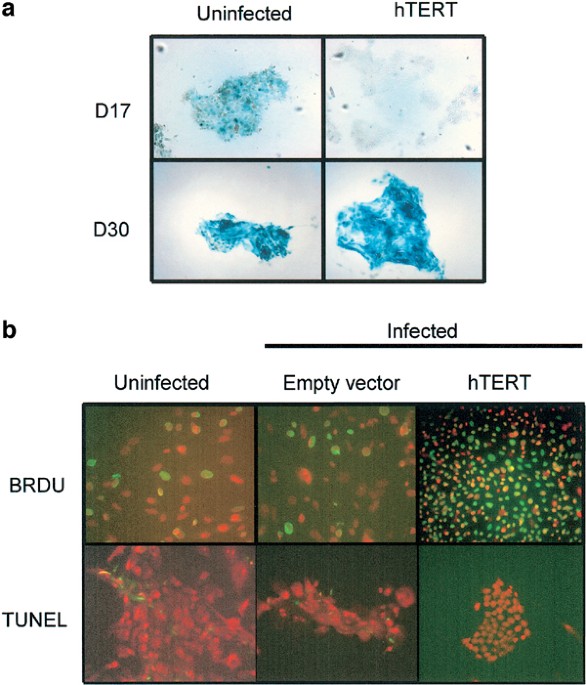
- Select a language for the TTS:
- UK English Female
- UK English Male
- US English Female
- US English Male
- Australian Female
- Australian Male
- Language selected: (auto detect) - EN
Play all audios:
ABSTRACT Our previous work showed that acquisition of immortality at the dysplasia stage of oral cancer progression was consistently associated with four changes: loss of retinoic acid
receptor (RAR)-_β_ and p16INK4A expression, p53 mutations and activation of telomerase. One atypical dysplasia (D17) that underwent delayed senescence after an extended lifespan showed loss
of RAR-_β_ and p16INK4A/p14ARF expression, but retained functional wild-type p53 and telomerase was not activated. We now demonstrate that retroviral delivery of hTERT results in telomere
lengthening and immortalization of D17 without loss of functional wild-type p53 activity. In contrast, the expression of hTERT in two other typical mortal dyplasia cultures (that retain
RAR-_β_ and p16INK4A expression) does not extend their lifespan, even though telomeres are lengthened. Access through your institution Buy or subscribe This is a preview of subscription
content, access via your institution ACCESS OPTIONS Access through your institution Subscribe to this journal Receive 50 print issues and online access $259.00 per year only $5.18 per issue
Learn more Buy this article * Purchase on SpringerLink * Instant access to full article PDF Buy now Prices may be subject to local taxes which are calculated during checkout ADDITIONAL
ACCESS OPTIONS: * Log in * Learn about institutional subscriptions * Read our FAQs * Contact customer support SIMILAR CONTENT BEING VIEWED BY OTHERS REPROGRAMMING OF THE ESOPHAGEAL SQUAMOUS
CARCINOMA EPIGENOME BY SOX2 PROMOTES ADAR1 DEPENDENCE Article 10 May 2021 A NON-GENETIC SWITCH TRIGGERS ALTERNATIVE TELOMERE LENGTHENING AND CELLULAR IMMORTALIZATION IN ATRX DEFICIENT CELLS
Article Open access 20 February 2023 SELF-SUSTAINING LONG-TERM 3D EPITHELIOID CULTURES REVEAL DRIVERS OF CLONAL EXPANSION IN ESOPHAGEAL EPITHELIUM Article Open access 23 September 2024
REFERENCES * Campisi J . (2000). _In vivo_, 14, 183–188. * Ghose A, Fleming J, El-Bayoumy K and Harrison PR . (2001). _Cancer Res._, 61, 7479–7487. * Gordon KE, Ireland H, Roberts M, Steegs
K, McCaul JA, MacDonald DG and Parkinson KE . (2002). _Cancer Res._, 63, 458–467. * Kresty LA, Mallery SR, Knobloch TJ, Song H, Lloyd M, Casto BC and Weghorst CM . (2002). _Cancer Res._, 62,
5295–5300. * Lustig AJ . (1999). _Proc. Natl. Acad. Sci. USA_, 96, 3339–3341. * McGregor F, Muntoni A, Fleming J, Brown J, Felix DH, MacDonald G, Parkinson EK and Harrison PR . (2002).
_Cancer Res._, 62, 4757–4766. * McGregor F, Wagner E, Felix D, Soutar D, Parkinson K and Harrison PR . (1997). _Cancer Res._, 57, 3886–3889. * Morris M, Hepburn P and Wynford-Thomas D .
(2002). _Oncogene_, 21, 4277–4288. * Munro J, Steeghs K, Morrison V, Ireland H and Parkinson EK . (2001). _Oncogene_, 20, 3541–3552. * Munro J, Stott FJ, Vousden KH, Peters G and Parkinson
EK . (1999). _Cancer Res._, 59, 2516–2521. * Ohtani N, Zebedee Z, Huot TJ, Stinson JA, Sugimoto M, Ohashi Y, Sharrocks AD, Peters G and Hara E . (2001). _Nature_, 409, 1067–1070. * Pandita
TK . (2002). _Oncogene_, 21, 611–618. * Papadimitrakopoulou V, Izzo J, Lippman SM, Lee JS, Fan YH, Clayman G, Ro JY, Hittelman WN, Lotan R, Hong WK and Mao L . (1997). _Oncogene_, 14,
1799–1803. * Ramirez RD, Morales CP, Herbert BS, Rohde JM, Passons C, Shay JW and Wright WE . (2001). _Genes Dev._, 15, 398–403. * Rheinwald JG and Beckett MA . (1981). _Cancer Res._, 41,
1657–1663. * Rheinwald JG, Hahn WC, Ramsey MR, Wu JY, Guo Z, Tsao H, De Luca M, Catricala C and O'Toole KM . (2002). _Mol. Cell. Biol._, 22, 5157–5172. * Serrano M, Lin AW, McCurrach
ME, Beach D and Lowe SW . (1997). _Cell_, 88, 593–602. * Shay JW . (1997). _J. Cell. Physiol._, 173, 266–270. * Smogorzewska A and de Lange T . (2002). _EMBO J._, 21, 4338–4348. * Stewart SA
and Weinberg RA . (2002). _Oncogene_, 21, 627–630. * Vaziri H and Benchimol S . (1998). _Curr. Biol._, 8, 279–282. * Webley K, Bond JA, Jones CJ, Blaydes JP, Craig A, Hupp T and
Wynford-Thomas D . (2000). _Mol. Cell. Biol._, 20, 2803–2808. * Xu D, Wang Q, Gruber A, Bjorkholm M, Chen Z, Zaid A, Selivanova G, Peterson C, Wiman KG and Pisa P . (2000). _Oncogene_, 19,
5123–5133. * Xu XC, Ro JY, Lee JS, Shin DM, Hong WK and Lotan R . (1994). _Cancer Res._, 54, 3580–3587. Download references ACKNOWLEDGEMENTS We are grateful to Dr H Vaziri for his generous
gift of the hTERT retroviral construct. We are grateful to Professors J Wyke and B Ozanne for critically reading the manuscript. AM was supported by the Glasgow Cancer School and White Lily
Trust; PRH, KEP, JF and KG by Cancer Research UK and KH by Glasgow University. AUTHOR INFORMATION Author notes * Alessandra Muntoni Present address: Children's Medical Research
Institute, 214 Hawkesbury Road, 2145, Westmead, NSW, Australia AUTHORS AND AFFILIATIONS * The Beatson Institute for Cancer Research, CRC Beatson Laboratories, Garscube Estate, Switchback
Road, Bearsden, Glasgow, G61 1BD, UK Alessandra Muntoni, Janis Fleming, Katrina E Gordon, Keith Hunter, Fiona McGregor, E Kenneth Parkinson & Paul R Harrison Authors * Alessandra Muntoni
View author publications You can also search for this author inPubMed Google Scholar * Janis Fleming View author publications You can also search for this author inPubMed Google Scholar *
Katrina E Gordon View author publications You can also search for this author inPubMed Google Scholar * Keith Hunter View author publications You can also search for this author inPubMed
Google Scholar * Fiona McGregor View author publications You can also search for this author inPubMed Google Scholar * E Kenneth Parkinson View author publications You can also search for
this author inPubMed Google Scholar * Paul R Harrison View author publications You can also search for this author inPubMed Google Scholar CORRESPONDING AUTHOR Correspondence to Paul R
Harrison. RIGHTS AND PERMISSIONS Reprints and permissions ABOUT THIS ARTICLE CITE THIS ARTICLE Muntoni, A., Fleming, J., Gordon, K. _et al._ Senescing oral dysplasias are not immortalized by
ectopic expression of hTERT alone without other molecular changes, such as loss of INK4A and/or retinoic acid receptor-_β_: but p53 mutations are not necessarily required. _Oncogene_ 22,
7804–7808 (2003). https://doi.org/10.1038/sj.onc.1207085 Download citation * Received: 07 January 2003 * Revised: 16 July 2003 * Accepted: 05 August 2003 * Published: 30 October 2003 * Issue
Date: 30 October 2003 * DOI: https://doi.org/10.1038/sj.onc.1207085 SHARE THIS ARTICLE Anyone you share the following link with will be able to read this content: Get shareable link Sorry,
a shareable link is not currently available for this article. Copy to clipboard Provided by the Springer Nature SharedIt content-sharing initiative KEYWORDS * head and neck cancer *
preneoplasia * immortalization * RAR-_β_ * INK4A * telomerase






